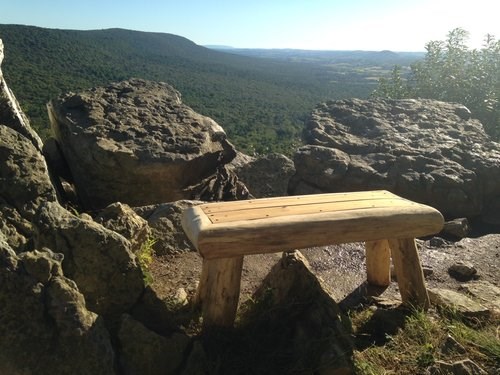Nature's Reverberations
Posted on in On the Mountain by Rachel Iola Spagnola, Senior Educator
What would a perfect day at Hawk Mountain Sanctuary look like to you? Like a page out of “Goldilocks and the Three Bears,” the outside temperature on the ridgetop was not too hot and not too cold. The humidity was not too high, not too low, the breeze was not too strong, not too weak. You know the story –the conditions for an educational adventure were just right.
Prior to the arrival of my group, I took a sound survey by simply closing my eyes and listening to the environment. Shortly after hearing the sound of a vehicle engine approaching, I welcomed a group of folks from the Vision Resource Center of Berks County, who were accompanied by a handsome and well-trained guide dog named Winston.
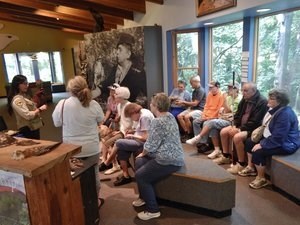
We took a seat on the carpeted benches next to the bird feeder station just a few footsteps through the Visitor Center’s front doors. I gazed at the larger-than-life mural of our founder, Mrs. Rosalie Edge, as I introduced Hawk Mountain as a Sanctuary, a protected place for all animals, plants, rocks, sticks, and even spiders. I aimed to provide an extra safe place for my group, many who were visiting Hawk Mountain Sanctuary for the very first time, and some who had permanent vision loss.
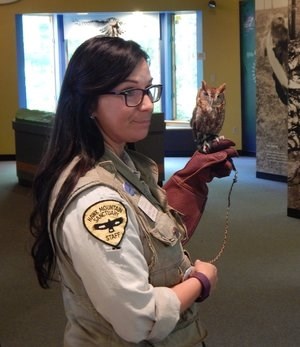
To complement our discussion on raptors and help visualize the amazing animal diversity found in the Appalachian Forest, I passed around feathers, snake skins, turtle shells, and the tail of a gray squirrel, while I introduced my avian coworker to the group. Although we do not allow or encourage touching raptors, as the live bird stood on my gloved hand, I passed around a life-size plastic replica of an eastern screech owl (Megascops asio). We also felt real raptor talons and compared a feathered foot of a great horned owl (Bubo virginianus) in contrast to the smooth, scaly toes of a red-tailed hawk (Buteo jamaicensis). With the aid of real raptor wings, we listened to the noisy wing of a diurnal hawk and felt a gust of air against our cheeks. In contrast, we struggled to hear the near silent flap of an owl’s wing and agreed that these amazing nocturnal adaptations allow owls hunt with the element of surprise.
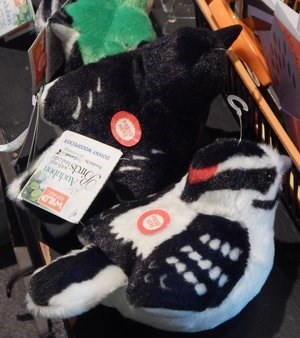
In addition to the owls’ adaptation of being silent flyers, we discussed the art of camouflage and how this adaptation helps many animals blend into an environment. Our group embraced our inner facial disk by listening to several songs of common birds like the eastern towhee and black-capped chickadee with the aid of Audubon bird toys and my very own rendition of a “miniature horse and trill” of an eastern screech owl, which seemed to evoke a soft whimper from the otherwise silent guide dog Winston. I even revealed one of Hollywood’s secrets: bald eagles are actually lip synching to the impressive screams of Red-tailed Hawks when filmed in movies and television. Several folks recognized this familiar call.
Walking outdoors, we encountered a pollinator party—bees buzzing and hummingbirds humming. Okay, they don’t actually hum. The sound of those tiny wings beating is what generates the humming noise that we could hear from the thick patches of bee balm located just in front of the Visitor Center. In the Native Plant Garden, many folks commented on the warmth of the sun and fragrant aroma of blooming swamp rose. I also couldn’t pass up an opportunity to highlight Turkey Vultures as raptors who sniff out their meals with their incredible olfactory sense. We agreed to leave the smell of fresh baked bread and cookies to us and let the Turkey Vultures remain nature’s garbage collectors, cleaning up road kill.
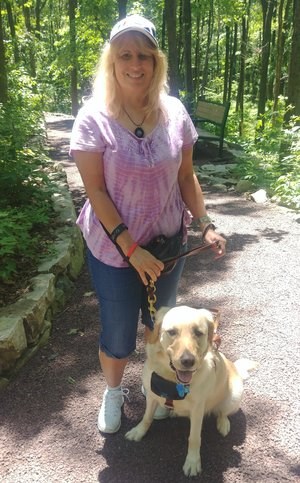
As we explored the pond from the deck, we listened for frogs calling and heard turtles leaving their exposed log perches for the safety of thick patches of water lilies. We enjoyed birds singing from all layers of the forest—delicate warblers hopping after insects in the canopy, catbirds curiously watching us from nearby branches, and the familiar sounds of robins foraging through the leaf litter.
Crossing Hawk Mountain Road was also a new experience for most of these folks. We navigated the crosswalk by listening for on-coming traffic, and I provided a grateful thumbs up and smile to those drivers who slowed down. We took the Silhouette Trail one step at a time, taking advantage of the opportunity to rest at the benches before reaching our destination at South Lookout. As Winston led the way, he sniffed his way past Mountain Laurels and Rhododendroa to the flat, open area looking down toward the Kempton Valley. Once again my star students could tell they were in an open area since the sun warmed our faces and the soft, gentle breeze rocked the nearby trees.
Although not everyone could see the view, we all felt the magic of this very special place, the birthplace of raptor conservation.
